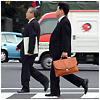Learn About Japan > Work and Workplaces in Japan > Employment > Group Employment Trips

|

Employment
- Group Employment Trips
- Spring Employment Season
- Hiring New Graduates
- Hiring New High School Graduates
- The Japanese Employment System
- Lifetime Employment
- The Seniority Wage System (nenkō joretsu)
- The Bonus System
- Enterprise Unions in Japan
- Enterprise Union Cooperation
- Unemployment Insurance
- Dual Tracks in Female Occupations: Ippan Shoku (Non-Career Track) and Sōgō Shoku (Career Track)
- Increase of Female Employees
- Female dominant occupations
- Post-Retirement Employment and Social Security
- Marriage Retirement and Retirement Ages for Men and Women
- Relations between Large and Small Companies
- Part-time Female Workers
- What Kinds of Work Do People Do in Japan?
- Freeter/ Furita: Part-Time Workers in Japan
|

Junior high school graduates from Amami Island came en masse to Tokyo to work. Photo from 1958.
Photo from Mainichi Shimbun.
Group Employment Trips
During the 1950s and 1960s, most young people from rural areas of Japan could not afford to go to high school, but went to work after they completed junior high school. It was common for a large group of these fifteen or sixteen year old junior high school graduates from one village to travel together to a large city to seek work, a practice called shūdan shūshoku.Employers were eager to hire young, unskilled workers from the countryside who were accustomed to hard work and a low standard of living. They called them “golden eggs” (kin no tamago). For the young people, finding work in a big city was a dream come true, but many gave up and returned home after a few months. Such groups of new graduates came from remote islands and from as far away as Okinawa, which was still under American Occupation. Click on PICTURES to see them.
|
|
|
| Download Podcast in
English
| Japanese
|
|
Document |
Audio-Video |
Chart |
Picture |
Map
|
|

